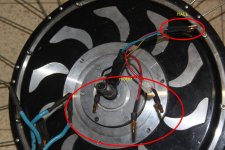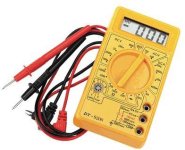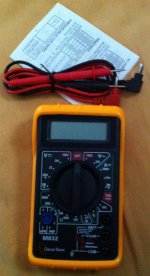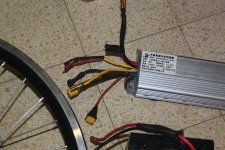dogman said:Slow down, calm down, read our advice carefully.
Bear in mind one cruicial thing. " I put the battery on charge all night" is NOT the same thing as " I confirmed with a voltmeter that the battery actually got charged overnight" never used a voltemeter have no idea how to use it
Here's a classic one for you. That green light on the charger? It means one of two things. A the battery is charged, or B the plug to the charger broke.on with pluge you talking about?, 1. the one connect the battrey? , 2. the one connect the electricity?
Re reliabliity, an ebike is only as good as the plug connections, and the battery being used. That's why we keep saying check the plugs and battery first. you dont belive me when i say i have checked?... i really did several times
i'll post pics thats may explain batter ....
View attachment 1
i am parking every time my bikes on my bulding yard and it has to be locked anti thefts , so i fugire it out i need to make it possible to take the controller and my battrey with my so thats why bullest as connectors, and also did a bullets close to the motor for it able to make adjasments like replace a tire or something like that if you guys have other ideas i would like to hear
at the moment i took everything out the bikes and made the regular becuas it dosent working
With properly connected plugs, and a decent quality lifepo4 battery, my ebikes have been as reliable as any cheap car. Sure, not as reliable as a $25,000 new car, but easily the bike was more reliable than a $5000 car. If anything, the only real problem is the same old one. Flat tires, since the roads are strewn with sheetrock and roofing nails.
You are using an out of date browser. It may not display this or other websites correctly.
You should upgrade or use an alternative browser.
You should upgrade or use an alternative browser.
motor dosent run
- Thread starter xlzeo
- Start date
Harold in CR
100 kW
In that 2nd photo, it looks like the Hall Sensor cable is folded under the controller ?? I blew up the photo in an imaging program, but, still could not tell exactly what you have ?
Where is the 5 strand hall sensor cable coming out of the axle ? I could not make that out, either ?
You REALLY need to get a voltmeter. Without that, you/we are all guessing. We can help you learn to use it. If you find some inexpensive ones, ($5.00) get a 2, because you could very well burn up the first, before letting us walk through your problem.
Believe this, the guys here ALL try to help ALL new members, no matter how little the new member understands.
This is THE best place on the internet to seek help. Might I ask what country you are in ? Sometimes the language barrier can be a problem. Just saying.
Where is the 5 strand hall sensor cable coming out of the axle ? I could not make that out, either ?
You REALLY need to get a voltmeter. Without that, you/we are all guessing. We can help you learn to use it. If you find some inexpensive ones, ($5.00) get a 2, because you could very well burn up the first, before letting us walk through your problem.
Believe this, the guys here ALL try to help ALL new members, no matter how little the new member understands.
This is THE best place on the internet to seek help. Might I ask what country you are in ? Sometimes the language barrier can be a problem. Just saying.
israelHarold in CR said:In that 2nd photo, it looks like the Hall Sensor cable is folded under the controller ?? I blew up the photo in an imaging program, but, still could not tell exactly what you have ?
Where is the 5 strand hall sensor cable coming out of the axle ? I could not make that out, either ?
You REALLY need to get a voltmeter. Without that, you/we are all guessing. We can help you learn to use it. If you find some inexpensive ones, ($5.00) get a 2, because you could very well burn up the first, before letting us walk through your problem.
Believe this, the guys here ALL try to help ALL new members, no matter how little the new member understands.
This is THE best place on the internet to seek help. Might I ask what country you are in ? Sometimes the language barrier can be a problem. Just saying.

View attachment 1
thats voltmeter right?

Harold in CR
100 kW
OK. If you say the one labeled hall is correct, that's OK with me.
YES, that is a volt-ohm meter. Without one, you have no way to check the things we mentioned to you. DO NOT try to use it, until you contact us again, once you get one. They are fairly easy to burn up.
YES, that is a volt-ohm meter. Without one, you have no way to check the things we mentioned to you. DO NOT try to use it, until you contact us again, once you get one. They are fairly easy to burn up.
dogman dan
1 PW
To reliably run an ebike for very long, you will need a voltmeter, and learn to use it.
Instructions that come with it should explain how to set it to test 20-200v, if not clear, ask us.
Once you plug in a battery that is needing charging, the chargers green light should turn red, or somthing like that, indicating that charging is taking place. If it stays green, that means that either the batttery is charged, or that the DC wire between the charger and the battery is broken. Often this happens at the plug, could be the battery side of the plug or the charger side of the plug. Or it could even be inside the battery itself, or inside the charger itself that the connection is broken.
Once you have a voltmeter, step one is to probe the battery and find out what voltage the battery is at. If low, and the charger won't run, then suspect a plug or a charger defect.
Chances are fairly good, that you simply have a broken charger, or broken plug, and that is why the bike won't run. Chargers are notoriously unreliable, while the bike itself tends to do better.
As for looking at the plugs, one thing I have learned in 30 years of construction work, is that while 100% of people look, only about 10% SEE. Some just need glasses, others can never learn to notice the tiny details. Plug contacts getting bent aside or pushing back out can be very very very hard to SEE, despite many looks. I am one who sees, but I still have to look hard to do it. Only experience teaches you what exactly you are trying to see, that's the catch 22 of it.
Instructions that come with it should explain how to set it to test 20-200v, if not clear, ask us.
Once you plug in a battery that is needing charging, the chargers green light should turn red, or somthing like that, indicating that charging is taking place. If it stays green, that means that either the batttery is charged, or that the DC wire between the charger and the battery is broken. Often this happens at the plug, could be the battery side of the plug or the charger side of the plug. Or it could even be inside the battery itself, or inside the charger itself that the connection is broken.
Once you have a voltmeter, step one is to probe the battery and find out what voltage the battery is at. If low, and the charger won't run, then suspect a plug or a charger defect.
Chances are fairly good, that you simply have a broken charger, or broken plug, and that is why the bike won't run. Chargers are notoriously unreliable, while the bike itself tends to do better.
As for looking at the plugs, one thing I have learned in 30 years of construction work, is that while 100% of people look, only about 10% SEE. Some just need glasses, others can never learn to notice the tiny details. Plug contacts getting bent aside or pushing back out can be very very very hard to SEE, despite many looks. I am one who sees, but I still have to look hard to do it. Only experience teaches you what exactly you are trying to see, that's the catch 22 of it.
dogman said:To reliably run an ebike for very long, you will need a voltmeter, and learn to use it. ok i'll buy 1 tomorrow
Instructions that come with it should explain how to set it to test 20-200v, if not clear, ask us. great thanks
Once you plug in a battery that is needing charging, the chargers green light should turn red, or somthing like that, indicating that charging is taking place. If it stays green, that means that either the batttery is charged, or that the DC wire between the charger and the battery is broken. Often this happens at the plug, could be the battery side of the plug or the charger side of the plug. Or it could even be inside the battery itself, or inside the charger itself that the connection is broken. the charger is ok, its preform like you say
Once you have a voltmeter, step one is to probe the battery and find out what voltage the battery is at. If low, and the charger won't run, then suspect a plug or a charger defect. i have this wattmater http://www.hobbyking.com/hobbyking/store/__10080__Turnigy_130A_Watt_Meter_and_Power_Analyzer.html is it good for test the battrey V?
Chances are fairly good, that you simply have a broken charger, or broken plug, and that is why the bike won't run. Chargers are notoriously unreliable, while the bike itself tends to do better.
As for looking at the plugs, one thing I have learned in 30 years of construction work, is that while 100% of people look, only about 10% SEE. Some just need glasses, others can never learn to notice the tiny details. Plug contacts getting bent aside or pushing back out can be very very very hard to SEE, despite many looks. I am one who sees, but I still have to look hard to do it. Only experience teaches you what exactly you are trying to see, that's the catch 22 of it.
ok so i bought voltemeter and i have 4.7 v battrey is it ok?, iv notice i have few option on the voltmeter how to check the hall sensors on the motor?, can i check the controller too?, how to check battrey Voltage?

ok so iv tried to preform the motor hall sensors and thats what i did hoped did it currect
battrey pack of 4.8v
battrey - red battrey wire connected to red wire on hall & black battrey wire connected to black hall wire
voltemeter - red connected to red hall wire, black tased the blure , green, yellow each on on hes time while i spin the motor iv got from each 0-4v max each cheack
what thats means?
how do i check the controller?
how to check battrey?
thanks
battrey pack of 4.8v
battrey - red battrey wire connected to red wire on hall & black battrey wire connected to black hall wire
voltemeter - red connected to red hall wire, black tased the blure , green, yellow each on on hes time while i spin the motor iv got from each 0-4v max each cheack
what thats means?
how do i check the controller?
how to check battrey?
thanks
dogman dan
1 PW
Looks like your halls are ok then, if you saw the voltage switching on and off as you spun the wheel.
To check the battery voltage, set the voltage range to 20-200v. Or whatever, just have it on a setting high enough, not 0-20v. On mine, it's 20-200v
Then probe with the wires on the plug from the battery to the controller. Fully charged "48v" is at least 53v, preferably 56-60v.
Try the same thing on the chargers DC output plug. If you see 58v, good!
Then you might try putting the battery to charging, hopefuly the red light goes on, and see what your battery voltage is then, measured on the plug to the controller.
Compare readings with the wattmeter, see if the wattmeter is accurate at all.
I don't know how to test controllers with just a voltmeter. I bought the motor controller tester, so I never bothered to learn another way to test controllers.
I still suspect a battery or charger problem. What exactly do you have for a battery? Bet it's awfully small for a the powerfull controller you have.
To check the battery voltage, set the voltage range to 20-200v. Or whatever, just have it on a setting high enough, not 0-20v. On mine, it's 20-200v
Then probe with the wires on the plug from the battery to the controller. Fully charged "48v" is at least 53v, preferably 56-60v.
Try the same thing on the chargers DC output plug. If you see 58v, good!
Then you might try putting the battery to charging, hopefuly the red light goes on, and see what your battery voltage is then, measured on the plug to the controller.
Compare readings with the wattmeter, see if the wattmeter is accurate at all.
I don't know how to test controllers with just a voltmeter. I bought the motor controller tester, so I never bothered to learn another way to test controllers.
I still suspect a battery or charger problem. What exactly do you have for a battery? Bet it's awfully small for a the powerfull controller you have.
its a 48V 12 ah Lifepo4 battreydogman said:Looks like your halls are ok then, if you saw the voltage switching on and off as you spun the wheel.
To check the battery voltage, set the voltage range to 20-200v. Or whatever, just have it on a setting high enough, not 0-20v. On mine, it's 20-200v
Then probe with the wires on the plug from the battery to the controller. Fully charged "48v" is at least 53v, preferably 56-60v. battrey gives 54.5v
Try the same thing on the chargers DC output plug. If you see 58v, good! when i connect the charger the green light turn to red till it fully charge the it get back to green
Then you might try putting the battery to charging, hopefuly the red light goes on, and see what your battery voltage is then, measured on the plug to the controller.
Compare readings with the wattmeter, see if the wattmeter is accurate at all. its accurate
I don't know how to test controllers with just a voltmeter. I bought the motor controller tester, so I never bothered to learn another way to test controllers. tasted the thorttle too its good
I still suspect a battery or charger problem. What exactly do you have for a battery? Bet it's awfully small for a the powerfull controller you have.
i quiet sure the controller make the problem , does anyone think of what can be bad on the controller and there is a way to fix it?
dogman dan
1 PW
If it's accurate, and your charger shuts off when it reaches 53v, there is part of the problem. 53v could be as much as 75% discharged, or as much as 75% charged. Full charged will be about 56v. One cell at 0v since lifepo4 charges to 3.5v per cell, can cripple your battery, and leave 53v showing.
You might want to see what voltage your charger is putting out. It should be between 56 and 60v.
I only know one simple test for controllers. You can test for shorted fets by spinning the wheel, and noting how much resistance you get. If it's a lot with the controller disconnected, you havfe shorted phases in the motor. Plug in the controller. If the fets in that controller are shorted, then you will see much more resistance now.
To see what this resistance shoud be like, you can short two of the big phase power wires of the motor to each other, with the controller unplugged of course. Touch two wires, and the wheel will get very very hard to turn.
You might want to see what voltage your charger is putting out. It should be between 56 and 60v.
I only know one simple test for controllers. You can test for shorted fets by spinning the wheel, and noting how much resistance you get. If it's a lot with the controller disconnected, you havfe shorted phases in the motor. Plug in the controller. If the fets in that controller are shorted, then you will see much more resistance now.
To see what this resistance shoud be like, you can short two of the big phase power wires of the motor to each other, with the controller unplugged of course. Touch two wires, and the wheel will get very very hard to turn.
ok so i bought this kelly KBS72051L,20A,24-72V, Mini Brushless DC Controller, i have tired to understand from the manual how to connect but i am not sure and the instructions is kind confusing me, can any one try explain me what connect to what and what other wires can do , thanks
MAGICPIE3FOCUSPOWER
10 kW
Congratulations with your controller! :lol:
I have the same model, I can't get it work with Magic Pie 3 motor.
Have spend many hours troubleshooting.
O well I will not give up yet.... :lol:
I have the same model, I can't get it work with Magic Pie 3 motor.
Have spend many hours troubleshooting.
O well I will not give up yet.... :lol:
MAGICPIE3FOCUSPOWER said:Congratulations with your controller! :lol:
I have the same model, I can't get it work with Magic Pie 3 motor.
Have spend many hours troubleshooting.
O well I will not give up yet.... :lol:
UPDATE: wohooooooooooooooo, manage to connect the controller , ectually it was easy then i sespected, just each wire to its matched (each color to matched) and MAGIC its working didnt test in riding yet but i will tomorrow
i'll update again and might upload some photos from the project
MAGICPIE3FOCUSPOWER
10 kW
Waauuww you are very lucky! 8)
Still it's very strange mine didn't work when colours are matched.
Had to do phase wires swap combinations.
But I have the 48A 48V KBS controller, maybe that's the difference?
Still it's very strange mine didn't work when colours are matched.
Had to do phase wires swap combinations.
But I have the 48A 48V KBS controller, maybe that's the difference?
have no idea connect kelly they helped me alot be spesific with your questions the love to answer in chaineseMAGICPIE3FOCUSPOWER said:Waauuww you are very lucky! 8)
Still it's very strange mine didn't work when colours are matched.
Had to do phase wires swap combinations.
But I have the 48A 48V KBS controller, maybe that's the difference?
MAGICPIE3FOCUSPOWER
10 kW
Nice what is your top speed with this setup?
I'm not sur I'll check in the next few days and I'll post resultsMAGICPIE3FOCUSPOWER said:Nice what is your top speed with this setup?
Similar threads
- Replies
- 1
- Views
- 221
- Replies
- 9
- Views
- 1,189


